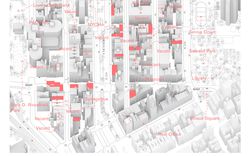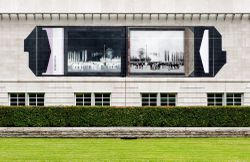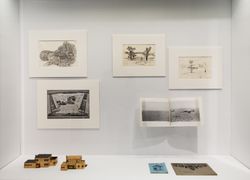Villa Weitz - Saint-François d'Assise - 1920-1924 - Salle des Fêtes - De La Croix-Rousse - 1924-1929
PH1986:0900.02
Description:
Album PH1986:0900.02 comprises 71 photographs of projects by architect Michel Roux-Spitz including Villa Weitz (1923), Église Saint-François d'Assise, and Salle des Fêtes De La Croix-Rousse, all in Lyon, France. Photographs of Villa Weitz show the façade, loggia, wrought iron gate, interior views with the staircase and vestibule, entrance door and hallway, living room, detail of the façade loggia and hall on the garden side, details of the mosaic, a display case, ceiling lamp in alabaster, bas-reliefs, study drawing for an interior and several views of a scale model. Photographs of the Église Saint-François d'Assise show views of the dome in glass concrete, the mosaic and iron balustrade. Several photographs show views of the Salle des Fêtes De La Croix-Rousse including the basement, ground floor, first and second floor plans, longitudinal section, main façade, the building site, rear façade, the staircase, the dome with glass by the Saint-Gobain factory in Lyon, the front lobby, the promenoir on the ground and first floors, the entrance with concrete clautras, overall views of the entrance, the gallery and rest area, entrance doors, the ventilation shield on the ceiling, views of one of the two staircases with walls made of concrete mullions and cathedral glass, concrete gutters and stairs made of massive Villebois stone, overall views of the concert hall, the orchestra and the stage.
architecture, interior design
1920-1929
Villa Weitz - Saint-François d'Assise - 1920-1924 - Salle des Fêtes - De La Croix-Rousse - 1924-1929
Actions:
PH1986:0900.02
Description:
Album PH1986:0900.02 comprises 71 photographs of projects by architect Michel Roux-Spitz including Villa Weitz (1923), Église Saint-François d'Assise, and Salle des Fêtes De La Croix-Rousse, all in Lyon, France. Photographs of Villa Weitz show the façade, loggia, wrought iron gate, interior views with the staircase and vestibule, entrance door and hallway, living room, detail of the façade loggia and hall on the garden side, details of the mosaic, a display case, ceiling lamp in alabaster, bas-reliefs, study drawing for an interior and several views of a scale model. Photographs of the Église Saint-François d'Assise show views of the dome in glass concrete, the mosaic and iron balustrade. Several photographs show views of the Salle des Fêtes De La Croix-Rousse including the basement, ground floor, first and second floor plans, longitudinal section, main façade, the building site, rear façade, the staircase, the dome with glass by the Saint-Gobain factory in Lyon, the front lobby, the promenoir on the ground and first floors, the entrance with concrete clautras, overall views of the entrance, the gallery and rest area, entrance doors, the ventilation shield on the ceiling, views of one of the two staircases with walls made of concrete mullions and cathedral glass, concrete gutters and stairs made of massive Villebois stone, overall views of the concert hall, the orchestra and the stage.
1920-1929
architecture, interior design
archives
Level of archival description:
Fonds
Bernard Cache fonds
AP169
Synopsis:
Bernard Cache, fonds, 1991-2011, document the development and design process for the Objectile firm and its decorative panels and furniture. The records focus mostly on daily activities of the firm, the collaboration of principal Bernard Cache with TopSolid software, and his parallel academic work. The records consist solely of original born-digital material.
1992-2011
Bernard Cache fonds
Actions:
AP169
Synopsis:
Bernard Cache, fonds, 1991-2011, document the development and design process for the Objectile firm and its decorative panels and furniture. The records focus mostly on daily activities of the firm, the collaboration of principal Bernard Cache with TopSolid software, and his parallel academic work. The records consist solely of original born-digital material.
archives
Level of archival description:
Fonds
1992-2011
Project
CI005.S1.1915.PR2
Description:
Oud designed a traditional West Netherlands farmhouse for his clients, Mr and Mrs Van Essen-Vinckers, in Blaricum, 1915. He revised his original design into the more modest Essen-Vinckers Villa. Oud was challenged to incorporate four bedrooms into the scaled down dwelling. The amended design featured a prominent chimney projecting from the living room through to the balcony and the upstairs bedroom (Taverne et al. 2001, 77-78). The project series includes plans as well as photographs of exterior views of the villa.
1915
Essen-Vinckers Villa, Blaricum, Netherlands (1915-1916)
Actions:
CI005.S1.1915.PR2
Description:
Oud designed a traditional West Netherlands farmhouse for his clients, Mr and Mrs Van Essen-Vinckers, in Blaricum, 1915. He revised his original design into the more modest Essen-Vinckers Villa. Oud was challenged to incorporate four bedrooms into the scaled down dwelling. The amended design featured a prominent chimney projecting from the living room through to the balcony and the upstairs bedroom (Taverne et al. 2001, 77-78). The project series includes plans as well as photographs of exterior views of the villa.
project
1915
Project
Riverplace, Columbus, Ohio
AP143.S4.D81
Description:
File documents the unexectued project for Riverplace, Columbus, Ohio. Material in this file was produced in 1986 and 1989. File contains design development drawings, presentation drawings, presentation panels, reference drawings, and textual records. The design development drawings comprise sketches, site studies, and a series of Columbus, Ohio scaling analysis studies. Reference drawings include maps, aerial photos of Columbus, and a schematic plan by Cossutta & Associates, Architects, dated 1986. Textual records include filing index and directory, meeting minutes, transmittals and sketches.
1986, 1989
Riverplace, Columbus, Ohio
Actions:
AP143.S4.D81
Description:
File documents the unexectued project for Riverplace, Columbus, Ohio. Material in this file was produced in 1986 and 1989. File contains design development drawings, presentation drawings, presentation panels, reference drawings, and textual records. The design development drawings comprise sketches, site studies, and a series of Columbus, Ohio scaling analysis studies. Reference drawings include maps, aerial photos of Columbus, and a schematic plan by Cossutta & Associates, Architects, dated 1986. Textual records include filing index and directory, meeting minutes, transmittals and sketches.
File 81
1986, 1989
articles
9 January 2023
Without even trying, retail is civic and political
Hilary Sample interviewed by Jack Self on how architects can respond to the changing urban dynamics of retail
Actions:
Created on the occasion of the Mois de la Photo à Montréal 2009, Canadian photographer Robert Burley’s Photographic Proof is a large-scale photographic installation on the north facade of the CCA. The mural reproduces a processed Polaroid photograph, symmetrically juxtaposing the negative and positive versions of the same image, and shows an unidentified crowd observing(...)
North façade
11 September 2009 to 19 October 2009
Robert Burley: Photographic Proof
Actions:
Description:
Created on the occasion of the Mois de la Photo à Montréal 2009, Canadian photographer Robert Burley’s Photographic Proof is a large-scale photographic installation on the north facade of the CCA. The mural reproduces a processed Polaroid photograph, symmetrically juxtaposing the negative and positive versions of the same image, and shows an unidentified crowd observing(...)
North façade
Starting From... Travel
Interpreting the subject of travel to distant places, the exhibition charts an expanded notion of travel that spans imaginary journeys, strange sites, vanishing points, floating and portable houses, endless caves, swirling diamond domes, tombs, crypts and catacombs, tunnel adventures, formal studies, technical innovation, cultural imagination, and experimental(...)
Hall cases
3 December 2008 to 1 May 2009
Starting From... Travel
Actions:
Description:
Interpreting the subject of travel to distant places, the exhibition charts an expanded notion of travel that spans imaginary journeys, strange sites, vanishing points, floating and portable houses, endless caves, swirling diamond domes, tombs, crypts and catacombs, tunnel adventures, formal studies, technical innovation, cultural imagination, and experimental(...)
Hall cases
archives
Level of archival description:
Collection
CD033
Synopsis:
The Aldo Cibic Microrealities project collection primarily consists of presentation materials, publications and born digital materials, like videos and photographs, by Aldo Cibic produced between 2003 and 2008 for the project “Microrealities”.
2003-2008
Aldo Cibic Microrealities project collection
Actions:
CD033
Synopsis:
The Aldo Cibic Microrealities project collection primarily consists of presentation materials, publications and born digital materials, like videos and photographs, by Aldo Cibic produced between 2003 and 2008 for the project “Microrealities”.
archives
Level of archival description:
collection
2003-2008
Project
Carbon Tower (2001)
AP174.S1.2001.D1
Description:
This project file documents an unbuilt design by Testa & Weiser for Carbon Tower (2001), a forty-storey building made almost entirely of carbon fibre. The project was developed in parallel with scripting software designed while Peter Testa and Devyn Weiser co-directed the Emergent Design Group at MIT. "The tower consists of an interdependent set of parts: floor plates hang from a diagrid structure of bundled fibres reinforced by two double-helix covered ramps, which are run in and out of the structure and are themselves made of strands woven at a finer scale. A thin composite skin—glass would be too heavy—wraps the tower’s parts together. A collaboration with Arup in 2002 allowed Testa & Weiser to simplify the scheme even further, by moving all core elements, from elevators to structural supports, to the tower’s perimeter. To take full advantage of the flexibility and energy efficiency of composite materials, Testa & Weiser also imagined that the carbon fibre structures would be formed on site through a process called pultrusion."[1] The file contains a large number of digital files documenting the conceptual and design development of the project; consultation with Arup Consulting Engineers, New York; research on composite materials; fabrication of 3D printed physical models by 3D Systems and Windform; and exhibition of the project at several museums and galleries, including the Museum of Contemporary Art, Los Angeles and the Cooper-Hewitt Smithsonian Design Museum, New York. Also contained in the file are 56 paper drawings (including some sketches done on top of printed computer-aided designs) and two 3D printed physical models produced by 3D Systems. Sources: [1] Canadian Centre for Architecture. Archaeology of the Digital 12: Testa & Weiser, Carbon Tower, ed. Greg Lynn (2015), ISBN 978-1-927071-25-0.
2002-2014
Carbon Tower (2001)
Actions:
AP174.S1.2001.D1
Description:
This project file documents an unbuilt design by Testa & Weiser for Carbon Tower (2001), a forty-storey building made almost entirely of carbon fibre. The project was developed in parallel with scripting software designed while Peter Testa and Devyn Weiser co-directed the Emergent Design Group at MIT. "The tower consists of an interdependent set of parts: floor plates hang from a diagrid structure of bundled fibres reinforced by two double-helix covered ramps, which are run in and out of the structure and are themselves made of strands woven at a finer scale. A thin composite skin—glass would be too heavy—wraps the tower’s parts together. A collaboration with Arup in 2002 allowed Testa & Weiser to simplify the scheme even further, by moving all core elements, from elevators to structural supports, to the tower’s perimeter. To take full advantage of the flexibility and energy efficiency of composite materials, Testa & Weiser also imagined that the carbon fibre structures would be formed on site through a process called pultrusion."[1] The file contains a large number of digital files documenting the conceptual and design development of the project; consultation with Arup Consulting Engineers, New York; research on composite materials; fabrication of 3D printed physical models by 3D Systems and Windform; and exhibition of the project at several museums and galleries, including the Museum of Contemporary Art, Los Angeles and the Cooper-Hewitt Smithsonian Design Museum, New York. Also contained in the file are 56 paper drawings (including some sketches done on top of printed computer-aided designs) and two 3D printed physical models produced by 3D Systems. Sources: [1] Canadian Centre for Architecture. Archaeology of the Digital 12: Testa & Weiser, Carbon Tower, ed. Greg Lynn (2015), ISBN 978-1-927071-25-0.
Project
2002-2014
Project
AP198.S1.1997.PR01
Description:
Project records document OCEAN North’s design for their competition entry for the Töölö Football Stadium in Helsinki in 1997. The project was titled Open Arena by OCEAN North. The site for the football stadium was in the Töölö neighbourhood, between a park area including the Helsinki Olympic Stadium, and a residential area. OCEAN North’s entry was a building that would integrate with its natural surroundings while being able to accommodate a variety of activities and events. The structure for Open Arena has three topological surfaces. The first provides stadium access to the players and the public, and includes services such as restaurant, cafeteria, and bars. Its shape aims to integrate with the natural landscape. The second contains the audience seating areas, including VIP and press areas, and aimed to arrange the audience as if it was loosely dispersed on a hillside. The third topological surface consists of the roof. The Töölö Football Stadium marks the introduction of the Channelling Systems process, defining building’s integration to its surroundings and distributing functions across the structure. Records show different stages of the design process and include two digitized photographs of Plexiglas sections that were used to physically explore the design. Digital files are grouped under categories such as Board images, Board lay-out, Graft, Sections, Siteplans, digital model images, scanned plans and site images. This last directory contains digitized photographs of the grounds surrounding the Helsinki Olympic Stadium. All drawings are vector or raster images of the whole or parts of the structure, with some including the identifications of the structure’s parts. Project records also include preliminary or working plans. Most were drawn to scale on paper and some were printed from CAD drawings. They chiefly reflect the design work to define the surfaces and shapes of the stadium’s structure. Source: Ateljé Sotamaa. “Portfolio: Open Arena”. http://portfolio.sotamaa.net/Open-Arena accessed in February 2018.
1997
Open Arena – Töölö Football Stadium, international competition entry
Actions:
AP198.S1.1997.PR01
Description:
Project records document OCEAN North’s design for their competition entry for the Töölö Football Stadium in Helsinki in 1997. The project was titled Open Arena by OCEAN North. The site for the football stadium was in the Töölö neighbourhood, between a park area including the Helsinki Olympic Stadium, and a residential area. OCEAN North’s entry was a building that would integrate with its natural surroundings while being able to accommodate a variety of activities and events. The structure for Open Arena has three topological surfaces. The first provides stadium access to the players and the public, and includes services such as restaurant, cafeteria, and bars. Its shape aims to integrate with the natural landscape. The second contains the audience seating areas, including VIP and press areas, and aimed to arrange the audience as if it was loosely dispersed on a hillside. The third topological surface consists of the roof. The Töölö Football Stadium marks the introduction of the Channelling Systems process, defining building’s integration to its surroundings and distributing functions across the structure. Records show different stages of the design process and include two digitized photographs of Plexiglas sections that were used to physically explore the design. Digital files are grouped under categories such as Board images, Board lay-out, Graft, Sections, Siteplans, digital model images, scanned plans and site images. This last directory contains digitized photographs of the grounds surrounding the Helsinki Olympic Stadium. All drawings are vector or raster images of the whole or parts of the structure, with some including the identifications of the structure’s parts. Project records also include preliminary or working plans. Most were drawn to scale on paper and some were printed from CAD drawings. They chiefly reflect the design work to define the surfaces and shapes of the stadium’s structure. Source: Ateljé Sotamaa. “Portfolio: Open Arena”. http://portfolio.sotamaa.net/Open-Arena accessed in February 2018.
Project
1997


